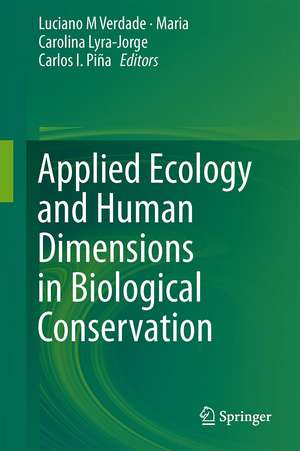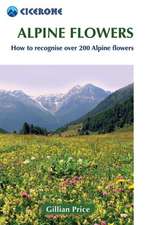Applied Ecology and Human Dimensions in Biological Conservation
Editat de Luciano M. Verdade, Maria Carolina Lyra-Jorge, Carlos I. Piñaen Limba Engleză Hardback – 22 mai 2014
| Toate formatele și edițiile | Preț | Express |
|---|---|---|
| Paperback (1) | 941.82 lei 43-57 zile | |
| Springer Berlin, Heidelberg – 23 aug 2016 | 941.82 lei 43-57 zile | |
| Hardback (1) | 945.79 lei 43-57 zile | |
| Springer Berlin, Heidelberg – 22 mai 2014 | 945.79 lei 43-57 zile |
Preț: 945.79 lei
Preț vechi: 1153.39 lei
-18% Nou
Puncte Express: 1419
Preț estimativ în valută:
180.97€ • 189.46$ • 149.75£
180.97€ • 189.46$ • 149.75£
Carte tipărită la comandă
Livrare economică 07-21 aprilie
Preluare comenzi: 021 569.72.76
Specificații
ISBN-13: 9783642547508
ISBN-10: 3642547508
Pagini: 280
Ilustrații: VIII, 228 p. 21 illus., 8 illus. in color.
Dimensiuni: 155 x 235 x 20 mm
Greutate: 0.45 kg
Ediția:2014
Editura: Springer Berlin, Heidelberg
Colecția Springer
Locul publicării:Berlin, Heidelberg, Germany
ISBN-10: 3642547508
Pagini: 280
Ilustrații: VIII, 228 p. 21 illus., 8 illus. in color.
Dimensiuni: 155 x 235 x 20 mm
Greutate: 0.45 kg
Ediția:2014
Editura: Springer Berlin, Heidelberg
Colecția Springer
Locul publicării:Berlin, Heidelberg, Germany
Public țintă
ResearchCuprins
Redirections in Conservation Biology.- Historical Ecology and the Explanation of Diversity: Amazonian Case Studies.- Phylogenetic Diversity and the Sustainable Use of Biodiversity.- Adaptation and Evolution in Changing Environments.- Biodiversity Loss and Infectious Diseases.- The Conservation Value of Agricultural Landscapes.- The Use of Molecular Tools in Ecological Studies of Mammalian Carnivores.- The Role of Abundance Estimates in Conservation Decision-Making.- Wildlife Surveys in Agricultural Landscapes: Terrestrial Medium- to Large-Sized Mammals.- Point Counts Method for Bird Surveys in Agroecosystems of the State of São Paulo, Southeastern Brazil.- The Use of Stable Isotopes Analyses in Wildlife Studies.- Multi-taxa Surveys: Integrating Ecosystem Processes and User Demands.- Who’s in Conflict with whom? Human Dimensions of the Conflicts Involving Wildlife.- BIOTA/FAPESP – The Biodiversity Virtual Institute: Translating Research on Biodiversity and Ecosystem Services into Policies in a Megadiverse Country.
Recenzii
From the book reviews:
“The 14-chapter, three-part volume provides convincing arguments about adding human aspects and governance questions to the topic of conservation and classic ecology worldwide. … A strength is the study area focus on Brazil. … Summing Up: Recommended. Upper-division undergraduates and above in conservation science.” (F. Huettmann, Choice, Vol. 52 (6), February, 2015)
“The 14-chapter, three-part volume provides convincing arguments about adding human aspects and governance questions to the topic of conservation and classic ecology worldwide. … A strength is the study area focus on Brazil. … Summing Up: Recommended. Upper-division undergraduates and above in conservation science.” (F. Huettmann, Choice, Vol. 52 (6), February, 2015)
Textul de pe ultima copertă
This book provides both the conceptual basis and technological tools that are necessary to identify and solve problems related to biodiversity governance. The authors discuss intriguing evolutionary questions, which involve the sometimes surprising adaptive capacity of certain organisms to dwell in altered and/or changing environments that apparently lost most of their structure and functionality. Space and time heterogeneities are considered in order to understand the patterns of distribution and abundance of species and the various processes that mold them. The book also discusses at which level—from genes to the landscape, including individuals, populations, communities, and ecosystems—men should intervene in nature in order to prevent the loss of biodiversity.
Caracteristici
Offers both technological tools and a conceptual basis required for the identification of problems related to biodiversity and their solution Written by experts in their fields Richly illustrated Includes supplementary material: sn.pub/extras











